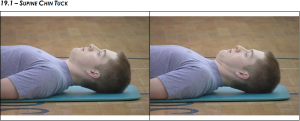I love talking about spines; it’s just a fascinating piece of machinery and I’m always trying to learn more about them.
And when you consider the fact that 80% of the US population will suffer from low back in their lives (90% if we include neck pain), it’s no wonder people like reading about them!
To give you a primer, let’s go back to the archives. Here are two video posts that I produced that discuss why we need to focus more of our training time and attention on achieving a neutral lumbar and cervical spine:
And if you’re too lazy, I’ll throw the video clips in here as well:
A big mistake I used to make
A few weeks ago at the Elite Training Workshop in Frisco, Texas, I admitted what I consider to be one of my biggest mistakes in recent years.
When I was producing these videos, I got really caught up in fixing one segment at a time.
It started with coaching and cuing neutral spine in the lower back.
But often, when we changed the position of one spinal segment, things changed at the other segments as well.
The bottom line is this: we can’t get too focused on any one segment.
They’re all important, and we have to understand that positional changes at one segment will typically lead to positional changes at adjacent segments.

This is why I firmly believe that a 4′ piece of PVC pipe is the greatest coaching/teaching tool we have at our disposal as strength coaches and personal trainers. We can teach virtually anyone to get into a more neutral spinal alignment by slapping the PVC pipe on their back and having them start moving through ranges of motion.
But what if you can’t get someone into an ideal alignment?
This is where you need to understand some of the common compensations you’re going to see as well as how to fix them up.
The lumbar and cervical spines are kindred spirits as they both have a lordotic (concave) curve to them.
Therefore when cuing a neutral lumbar position, it’s common to see changes at the cervical spine as well. The two most common compensations you’ll see are:
- We cue neutral lumbar, and they compensate by hyper-extending their neck, or
- They simply hang out in a head forward posture all the time.
How to Address Hyper-extension
To fix cervical extension, throw the PVC pipe on their back and tell them that they need to have three points of contact at all times – the back of the head, the upper back, and buttocks.
Think about someone performing a squat, RDL, or deadlift: As they move into hip flexion, if they go into cervical hyperextension, only the back of the head and their buttocks will be touching.
The kinesthetic awareness from the PVC should immediately improve their performance and neck alignment. It may also help to cue them to keep their head down but the eyes up.
You can also cue them to gently “pack” the neck. I would describe this but Charlie Weingroff did a fantastic job in his article below:

Weingroff: Packing In the Neck
A final way to describe this that people seem to “get” is when I describe that if you’re doing an RDL, you should look like one of those plastic birds sipping water.
The spine is locked or welded into place, and you’re focused on moving through the hips while maintaining that neutral alignment.
How to Address Head Forward Posture
If someone hangs out in a head forward posture, try coaching them to “pull” their head back. You can even try this while sitting at the computer – just think about pulling your head and neck “back” into a more neutral alignment.
If you do it correctly, you should feel a gentle activation in the front of your throat/neck, along with a gentle stretch on the back side.

Chances are some supplementary strengthening work for the deep neck flexors wouldn’t hurt, either. The supine chin tuck is a first-tier progression in Assess and Correct, and it’s something we’ll throw into our clients’ warm-ups to get them thinking about using the appropriate neck muscles to create stability.
To perform this exercise correctly: lay flat on your back on the floor, and while keeping the back of your head on the ground, think about pulling your chin towards your chest.
In an appropriate setting you can also tell your client to make a double chin, but you have to be a little bit more careful with this one. 🙂
This cue of “pulling” the neck back has made a big difference for me when squatting and deadlifting as well. I started to take heed when both Zach Moore and Lil’ Stevie gave me the same cue in the same week!
Last but not least, try and stay out of this head forward posture on your rowing and upper back exercises as well. Many will have a tendency to finish a row by driving the head forward, versus squeezing the shoulder blades back.
Summary
While good neck alignment is just one component of getting into an ideal or neutral spinal alignment, the tips and tricks above should help you consistently get yourself (or your clients) into better neck posture.
Give these a shot and let me know what you think!
All the best
MR

